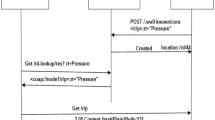Abstract
One of the noticeable characteristics of the Internet-of-Things (IoT) devices is that they are resource-constrained, which makes them incompatible with the standard Internet protocols, e.g., HTTP. Nevertheless, IoT offers the Constrained Application Protocol (CoAP) as an alternative protocol for IoT devices where it is considered to be lightweight in regard to power consumption, network traffic, and so on. The main challenges associated with CoAP, however, still remain unsolved where most of the state-of-the-art approaches group servers manually and return the exact matches only. To address these issues, we propose a novel Semantically Enhanced CoAP Gateway (SECoG) for complex service mashups. SECoG enables users to create a simple or complex CoAP service mashup via a single HTTP request. Furthermore, a prototype implementation of SECoG was deployed on a real-world testbed to evaluate the proposed approach in terms of the reliability, execution time, network traffic, and accuracy.











Similar content being viewed by others
References
Castro M, Jara AJ, Skarmeta AF (2016) Enabling end-to-end CoAP-based communications for the Web of Things. J Netw Comput Appl 59:230–236
Chun S, Seo S, Oh B, Lee K-H. (2015) Semantic description, discovery and integration for the Internet of Things. In: Proceedings of the international conference on semantic computing (ICSC), pp 272–275
Compton M, Barnaghi P, Bermudez L, GarcíA-Castro R, Corcho O, Cox S, Huang V et al (2012) The SSN ontology of the W3C semantic sensor network incubator group. Web Semant Sci Serv Agents World Wide Web 17:25–32
Fu X, Yue K, Liu L, Zou P, Feng Y (2015) Discovering admissible Web services with uncertain QoS. Front Comput Sci 9(2):265–279
Hajlaoui JE, Omri MN, Benslimane D, Barhamgi M (2017) QoS based framework for configurable IaaS cloud services discovery. In: Proceedings of the IEEE international conference on web services (ICWS), pp 460–467
Hasemann H, Kleine O, Krller A, Leggieri M, Pfisterer D (2013) Annotating real-world objects using semantic entities. In: Proceedings of the European conference on wireless sensor networks (EWSN), February 2013, pp 67–82
Han SN, Khan I, Lee GM, Crespi N, Glitho RH (2016) Service composition for IP smart object using realtime Web protocols: concept and research challenges. Comput Stand Interfaces 43:79–90
Hou CD, Li D, Qiu JF, Shi HL, Cui L (2014) SeaHttp: a resource-oriented protocol to extend REST style for Web of Things. J Comput Sci Technol 29(2):205–215
Ishaq I, Hoebeke J, Van den Abeele F, Rossey J, Moerman I, Demeester P (2014) Flexible unicast-based group communication for CoAP-enabled devices. Sensors 14(6):9833–9877
Ishaq I, Hoebeke J, Moerman I, Demeester P (2016) Observing CoAP groups efficiently. Ad Hoc Netw 37:368–388
Jiang W, Wu T, Hu SL, Liu ZY (2011) QoS-aware automatic service composition: a graph view. J Comput Sci Technol 26(5):837–853
Jin X, Chun S, Jung J, Lee K-H (Nov 2014) IoT service selection based on physical service model and absolute dominance relationship. In: Proceedings of the international conference on service-oriented computing and applications (SOCA), pp 65–72
Jin X, Chun S, Jung J, Lee K-H (2016) A fast and scalable approach for IoT service selection based on a physical service model. Inf Syst Front 19(6):1357–1372
Jung J, Chun S, Jin X, Lee K-H (2016) Enabling smart objects discovery via constructing hypergraphs of heterogeneous IoT interactions. J Inf Sci. https://doi.org/10.1177/0165551516674164
Kim M, Oh B, Jung J, Lee K-H (2016) Outlier-robust web service selection based on a probabilistic QoS model. Int J Web Grid Serv 12(2):162–181
Kovatsch M, Lanter M, Shelby Z. (Mar 2014) Californium: scalable cloud services for the internet of things with CoAP. In: Proceedings of the IEEE world forum on Internet of Things (WF-IoT), pp 1–6
Ludovici A, Calveras A (2015) A proxy design to leverage the interconnection of CoAP wireless sensor networks with web applications. Sensors 15(1):1217–1244
Luo JZ, Zhou JY, Wu ZA (2009) An adaptive algorithm for QoS-aware service composition in grid environments. Serv Oriented Comput Appl 3(3):217–226
Moussa H, Gao T, Yen IL, Bastani F, Jeng JJ (2010) Toward effective service composition for real-time SOA-based systems. Serv Oriented Comput Appl 4(1):17–31
Resnik P (1995) Using information content to evaluate semantic similarity in a taxonomy. In: Proceedings of the international joint conference on AI (IJCAI), pp 448–453
Shelby Z, Bormann C (2014) Core resource directory. https://tools.ietf.org/html/draft-ietf-core-resource-directory-00. Accessed Aug 2018
Shelby Z, Hartke K, Bormann C (2014) The constrained application protocol (CoAP). https://tools.ietf.org/html/draft-ietf-core-coap-18. Accessed Aug 2018
Shin DH, Lee K-H, Ishikawa F (2014) A graph-based approach enhancing correctness and speed of web services composition through explicit specification of functional semantics. Int J Web Grid Serv 10(4):297–318
Wang H, Huang G, Yu Q (2016) Automatic hierarchical reinforcement learning for efficient large-scale service composition. In: Proceedings of the IEEE international conference on web services (ICWS), pp 57–64
Xu B, Luo S, Yan Y, Sun K (2012) Towards efficiency of QoS-driven semantic web service composition for large-scale service-oriented systems. Serv Oriented Comput Appl 6(1):1–13
Zeng L, Benatallah B, Dumas M, Kalagnanam J, Sheng QZ (2003) Quality driven web services composition. In: Proceedings of the international conference on World Wide Web (WWW), pp 411–421
Zhang MW, Zhang B, Liu Y, Na J, Zhu ZL (2010) Web service composition based on QoS rules. J Comput Sci Technol 25(6):1143–1156
Zhang R, Zettsu K, Kidawara Y, Kiyoki Y, Zhou A (2013) Context-sensitive Web service discovery over the bipartite graph model. Front Comput Sci 7(6):875–893
Zhu W, Bastani F, Yen I L, Fu J, Zhang Y (2017) Automated holistic service composition: modeling and composition reasoning techniques. In: Proceedings of the IEEE international conference on web services (ICWS), pp 596–603
Acknowledgements
This research was supported by Korea Electric Power Corporation (Grant No.: R18XA05).
Author information
Authors and Affiliations
Corresponding author
Additional information
Publisher's Note
Springer Nature remains neutral with regard to jurisdictional claims in published maps and institutional affiliations.
Rights and permissions
About this article
Cite this article
Jin, X., Jung, J., Chun, S. et al. SECoG: semantically enhanced mashup of CoAP-based IoT services. SOCA 13, 81–94 (2019). https://doi.org/10.1007/s11761-019-00254-0
Received:
Revised:
Accepted:
Published:
Issue Date:
DOI: https://doi.org/10.1007/s11761-019-00254-0




